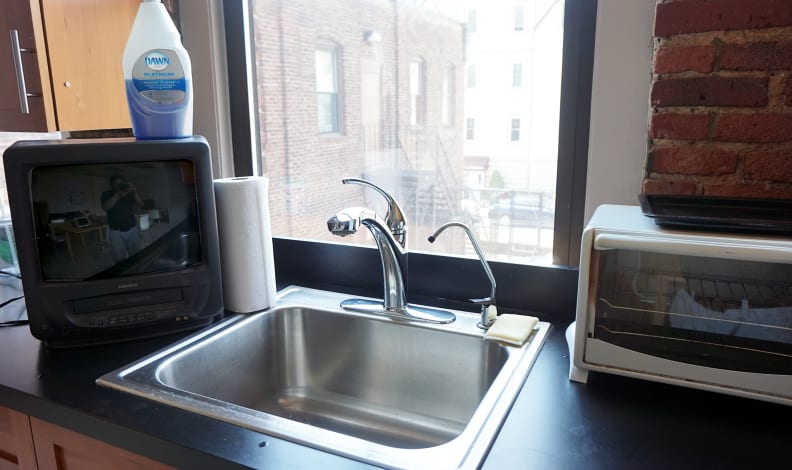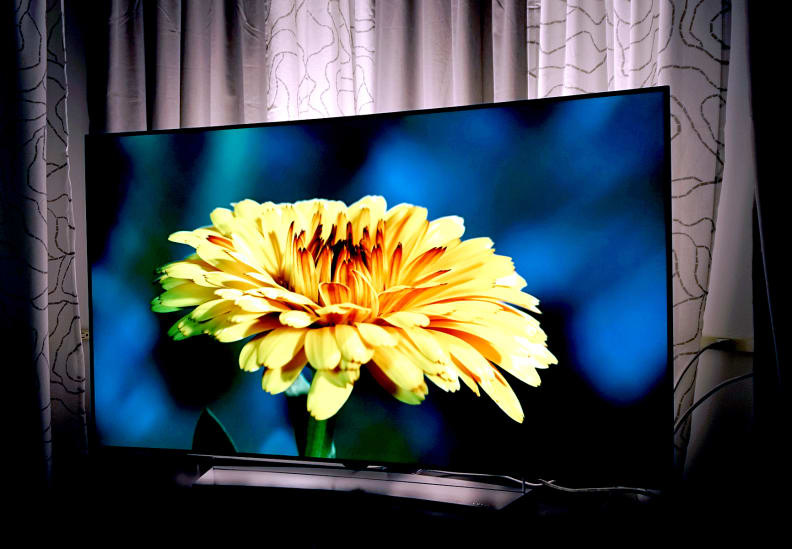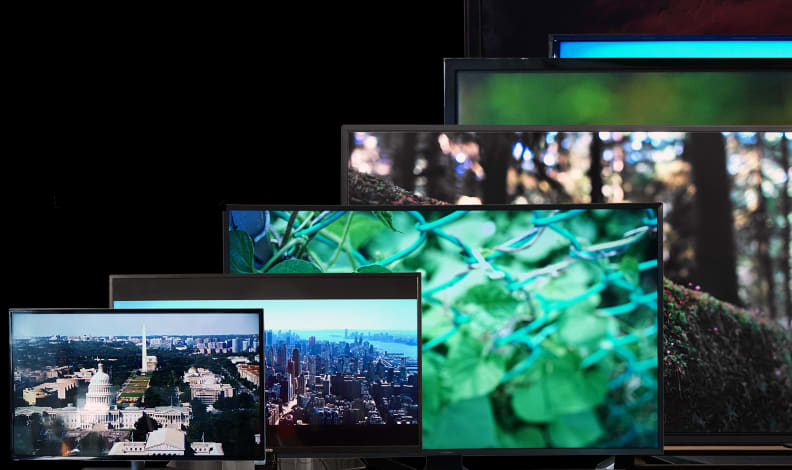40 Or 46 Inch Tv For Bedroom
What size TV should you buy? It's a simple question, and there's an equally simple answer: Buy the biggest, best one you can afford.
As reviewers, we spend a lot of time trying to find the deepest black levels and most accurate color reproduction. But ultimately, most buyers just want a cinematic experience without having to shell out $20 for a ticket and small popcorn. That's what you can get from the biggest screens.
But if you want to find the perfect fit, it's a bit more complicated. Here are some tips to help ensure your new TV fits just right into your viewing space.
Know Your Space
Pick a size that fits the room.
A TV for the living room is going to look completely different from an occasional use TV for the kitchen, garage, or bedroom. When you're choosing a new TV, matching the size to the room is a good way to narrow your options.
For example, small TVs (32 to 40-inch) are usually the best choice for a kitchen, bedroom, or guest room. They're cheaper and easier to move when you need the counter space—say, during the holidays or after big family events.

Credit: Reviewed.com / Lee Neikirk
Buy a TV to suit the focus of the room. Smaller sets are better suited to rooms where watching TV isn't the primary function.
Mid-size TVs (42 to 55-inch) will complement most living rooms and dens nicely. For a larger, shared room, mid-size TVs are big enough for everyone to watch, but not so big that you can't avoid them if you want some peace and quiet. Keep the family bookworm in mind!
If you're lucky enough to have a specially designed, dedicated home theater with controlled lighting and external audio, go for the biggest models (55 to 80-inch). Huge TVs command everyone's attention, so if your space was designed for TV time, go as big as you can.
Know Where the TV Will Go
You can move furniture around, but you can't make your TV bigger.
No matter whether you're squeezing your new TV into an entertainment center or mounting it on the wall, knowing where it's going to end up within the room can help you choose a size. You don't need to break out your blueprints. Just be conscious of how much room you have to work with.
Pick a spot that's free from lamp or window glare.
Our general advice still holds here: If you buy a TV that's a little too big for the space, you can usually move some furniture around to create a comfortable viewing environment. If you buy one that's too small, on the other hand, you can't just stretch it out later. And if you're worried a huge TV will be a pain to move around, keep in mind that today's sets are much lighter and thinner than they used to be.
But with that said, it is possible to go too big.
If you're wall-mounting, check the available wall width. If your TV is going to be sitting on a TV stand, find out how big of a set your stand can support. If you don't already own a stand, make sure you have room for one that's appropriately sized. Some TVs sit on central pedestals, while others have feet mounted to either side, so make sure your stand is wide enough to support your chosen foot configuration.
Finally, while you might think you know every inch of your living room, when you're being dazzled by flashy screens at the store it's easy to lose track of the details. The solution is simple: Take a photo of your room with your phone and bring it with you when you go shopping. A visual reminder of your room's layout can make eyeballing screen size a lot simpler.
The 4K Advantage
If you want to go huge (or sit really close), 4K is your friend.
The bigger a TV is, the more you have to design your viewing space around it. Bigger screens are more susceptible to reflections, produce more heat, and generally require more setup time and maintenance. Putting one of these behemoths in a room where kids are playing or someone always has a reading lamp on may cause you some headaches in the long-run.

Credit: Reviewed.com / Lee Neikirk
4K is a great choice for 50-inch or larger TVs.
And since resolution doesn't necessarily change with screen size, bigger TVs also tend to have have bigger pixels. The only risk in buying a huge TV is that if you sit too close to the screen, you might see those pixels. That can break your immersion.
This is the biggest advantage of 4K TVs, also referred to as Ultra High Definition (or UHD). With 4K TVs, you get four times as many pixels, meaning you can sit roughly twice as close as you could to a regular Full HD (1080p) TV without breaking your immersion. The principle can be reversed, too: You can double your screen size without changing your viewing distance, and you still won't notice individual pixels.
4K TV upscaling can cause input lag in video games.
If you want a really big TV, 4K is your best bet for an optimal viewing experience. There are shortcomings, however. Since they're still relatively new to the market, 4K sets more expensive than their 1080p counterparts. Content is also fairly scarce, though streaming services like Netflix and Amazon Prime have begun to release more UHD content.
There's one group who probably shouldn't consider 4K for now: serious console gamers. That's because all 4K TVs must "upscale" non-4K content, creating extra pixels to blow up 1080p video to 4K resolution. In our tests, we've found that this process can lead to input lag—a delay between button presses and action on the screen.
The Law of Diminishing Returns
Don't overpay for a TV that's only marginally bigger than another.
Here's a good rule of thumb: An extra 10+ inches makes a TV really feel bigger.
In other words, if you're upgrading from a 32-inch set, go for at least 42 inches; from a 40-incher, look for at least a 50-inch TV. Not only will your new TV probably perform better than the old one, but the difference in size will really wow you.

Credit: Reviewed.com / Lee Neikirk
If a 48-inch TV is notably cheaper than a 50, go for it. You're not going to miss a couple inches.
But keep in mind that there are diminishing returns when it comes to neighboring sizes. If a 48-inch TV is much more affordable than a 50-inch sibling, save your money and go for the slightly smaller size. You're not going to miss those two inches in everyday use.
Math Is Your Friend
If you're still not sure, break out the calculator.
These tips are a great way to get a general sense of how large your TV should be, and for most people that will be more than enough. But if you want to get technical, you can apply a little math to get a more scientific answer.
Two standards organizations—SMPTe and THX—use formulas to determine the field of view for an ideal viewing experience. Field of view refers to how much of your vision is taken up by the screen, and these formulas are what cinema chains use to plan out the seating placement in theaters.
You can use the same formulas to determine the minimum and maximum screen sizes for your viewing distance at home. Here's a simple breakdown:
- Minimum size: divide the distance to the screen (in inches) by 2.5.
- Maximum size: divide the distance to the screen by 1.2.
- Median size: divide the distance to the screen by 1.85
Need an example? If your couch is set up 7 feet (84 inches) from your screen, your minimum recommended screen size 33.6 inches (84 / 2.5), while your maximum recommended screen size is 70 inches (84 / 1.2). Everything in between is fair game, and a 42- or 48-inch set will get you closest to the median of 45.4 inches (84 / 1.85).
Finally, if you already have a TV, you can use the same formula to find the right viewing distance. Just flip it around and multiply the screen size by 1.85. For example, a good median distance from a 60-inch TV is 9.25 feet.
Source: https://www.reviewed.com/televisions/features/how-to-choose-the-right-tv-size


Tidak ada komentar: